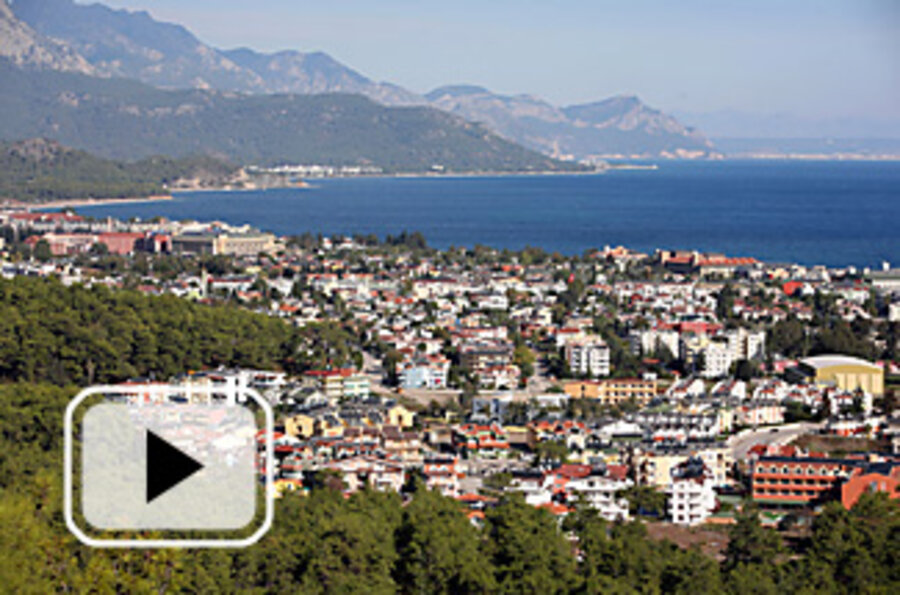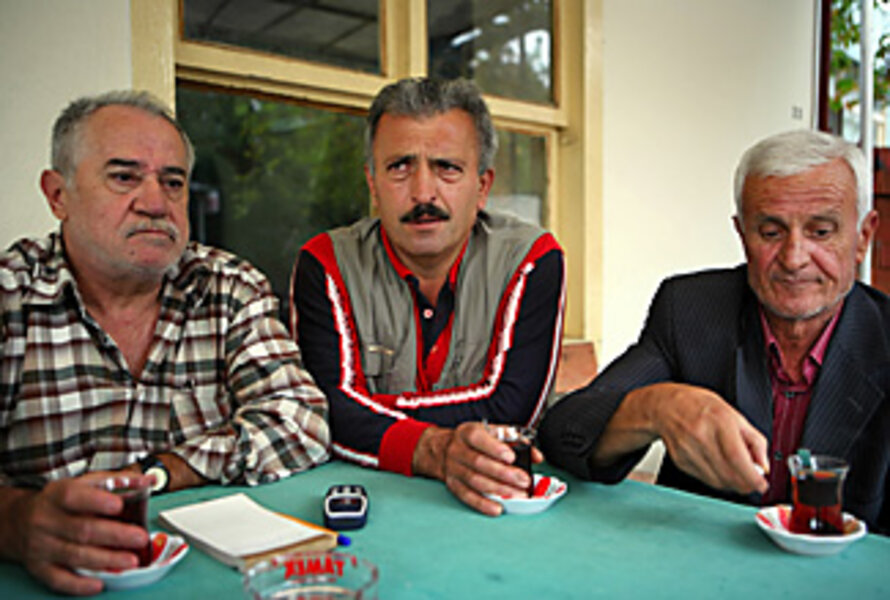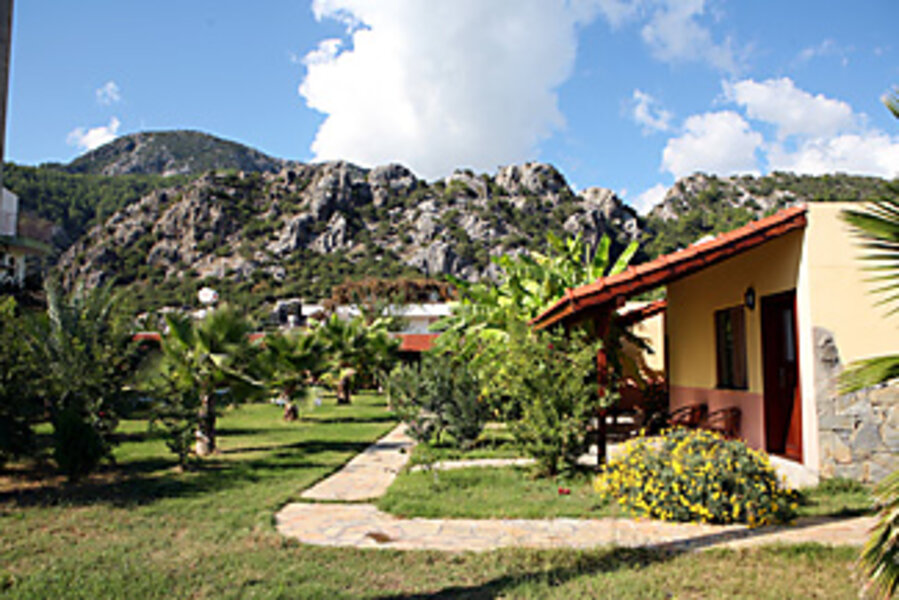As tourism booms, a push for new models
Loading...
| Kemer and Cirali, Turkey
On this strip of Mediterranean coast, two Turkish villages illustrate completely different paths to tourism development.
Located just 20 miles apart, Kemer and Cirali were once sleepy communities of citrus farmers, nestled between the lush mountains and the cerulean sea. But in the mid-1970s, their paths diverged.
Turkey designated the Kemer area as its first tourism development zone and, with World Bank loans, threw open the doors to builders. Five-star seaside hotels, restaurants, and nightclubs quickly sprouted. By 2005, Kemer had 75,000 hotel beds – triple the number planned.
Cirali stands in sharp contrast – a low-key paradise of family-run bed-and-breakfasts tucked among fruit trees. The sandy beach, bordered by ancient ruins, has been kept free of buildings to protect the nests of endangered loggerhead turtles. Tourism is Cirali's lifeblood, too, but its environmentally conscious accommodations and restaurants are a rare Mediterranean example of sustainable development.
This week, signatories to the 1976 Barcelona Convention meeting in Spain are expected to approve a new convention about coastal development that may help ensure that as Mediterranean tourism booms, there are more Ciralis and fewer Kemers.
Already the world's most popular tourist destination, the Mediterranean's appeal is growing. Drawn by its warm seas, ancient ruins, and unique cuisine, more than 175 million tourists visited the region's coast in 2000. By 2025, that number is expected to grow to 312 million.
Much of that new development is occurring in North Africa and on the Mediterranean's eastern coast, in areas that had previously seen scant tourism.
But the increasing demand for tourist facilities, along with expanding urban sprawl from booming coastal cities, is leading to a loss of about 125 miles of coastline a year, according to the Blue Plan, a United Nations project that examines development and environmental issues in the Mediterranean. Already, 40 percent of the sea's coasts have been built on; without new regulations, such as those being debated in Spain this week, that figure could rise to 50 percent in fewer than 20 years.
"All the tourists who are coming here, of course they bring money, but they also bring so much damage," says Annabelle Cuttelod, who coordinates the Mediterranean Red List – an international list of endangered species – for the World Conservation Union (IUCN). "The Mediterranean is really a place that is used, that is sometimes abused, and for which there is not a lot of concern or support by the rest of the world."
On the frontline of expanding tourism
The booming Antalya region of Turkey, which includes Kemer, is one of the most rapidly expanding fronts of Mediterranean tourism. Between 1990 and 2006, Antalya's tourism capacity grew 140 percent, according to the Antalya Chamber of Commerce and Industry. Almost 40 percent of Turkey's tourist beds are concentrated in Antalya, along a narrow strip coastal land less than a mile wide.
"Kemer is doing business now only because of its name. There is nothing special about it anymore," says Tuncay Cesur, who grew up nearby and now works for the World Wildlife Fund (WWF) in Cirali.
This rampant coastal development, with its towering hotels and built-up beaches, doesn't just destroy the view; it also extracts a heavy toll on the environment, destroying pristine natural habitats, spewing sewage and pollution into the sea, and causing the salinization of aquifers.
Environmentalists say development is the single biggest threat to the Mediterranean's biodiversity, which is amongst the world's most varied and unique. The fate of species like the majestic loggerhead sea turtle, which has only a few nesting grounds left in the eastern Mediterranean, and the monk seal, one of the most endangered mammals in the world, have received some attention. But dozens of lesser-known species are also at risk.
Of the Mediterranean Basin's 253 freshwater fish species, more than half are threatened and eight have become extinct, in large part because of pollution and water extraction, says the IUCN. A quarter of all amphibians and land mammals are also under threat.
But despite the environmental costs, tourism retains a strong allure, especially among the region's poorer nations, which look to the industry to spur growth. Turkey's tourist boom, for example, was driven largely by government incentives, says Erdal Ozhan, director of Medcoast, a nongovernmental organization that supports research on coastal development.
Kemer is a good example of that. Kaum Gul, a businessman who employs 250 people in his four Kemer hotels, lauds government efforts. "The more hotels, the better," he says.
But cafe owner Abdullah Kahraman, who once worked in a hotel, says his hometown would be better off without tourism. He says the jobs are only seasonal and pay minimum wage. Most of those who have grown rich, he contends, are not from Kemer. Mr. Gul, he says, is among a handful of local hotel owners.
"Some people are making lots of money," he admits. "But the locals, the people who sold the land, are working like slaves."
From 1976 to 2000, the number of hotel beds in Turkey rose to 508,632 from 47,307, according to the Turkish Statistical Institute.
By the mid-1990s, the government had stopped providing incentives to tourism, and the pace of development slowed. Now it has begun identifying important coastal areas – about a dozen so far – for special protection.
Increased protection of coastal areas
The creation of protected areas, especially along the sea's less-developed southern and eastern coasts, is one of the most significant steps being promoted to conserve the natural environment of the region. Countries there committed to the idea as part of the Mediterranean Action Plan, the Barcelona Convention's predecessor. Originally focused on protecting the sea, the convention was expanded in 1995 to include coastal areas as well.
But environmentalists warn that just designating protected areas is not enough.
"Designation does not mean management," says Dr. Ozhan. "Just paper-based management isn't effective."
The residents of Cirali, which now lies within a protected area, struggled hard against the onslaught of big development. Twenty years ago, when a former president of Turkey wanted to build a golf course there, residents rebelled. Over the years, with the help of environmental groups like WWF, they pushed for new regulations to protect the turtle nesting grounds and limit the size of development.
Today, local farmers are turning organic, and almost everyone is proud they've protected Cirali's unique beauty. "This is an alternative form of development," says Ahmet Altintas, owner of the small Azur hotel. "If you sell the land, you have nothing. Here we are the ones who are benefiting from tourism. Development and the environment can work together."








